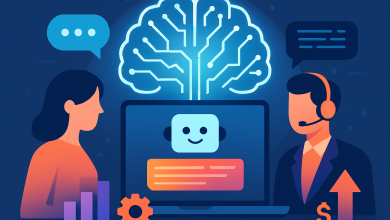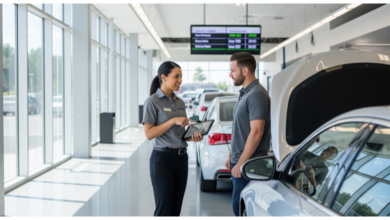The automotive industry has entered a digital-first era where cars are no longer just machines for transport; they’re smart, connected systems designed to improve safety, comfort, and performance. Among these advancements, automotive apps have emerged as crucial players.
They allow real-time monitoring, remote control, driver assistance, and predictive analytics that collectively enhance road safety. From accident prevention to emergency response, these applications are bridging the gap between human drivers and intelligent machines.
This blog explores how automotive apps are transforming vehicle safety features, what innovations are driving this trend, and why they’re becoming indispensable for manufacturers, drivers, and regulators alike.
Role of Automotive Apps in Enhancing Vehicle Safety Features
The automotive apps do offer features such as real-time vehicle tracking, crash alerts, and driver monitoring systems to keep vehicles in optimal condition.
Let’s learn the complete role of automotive apps, below.
1. Real-Time Vehicle Monitoring
One of the biggest contributions of automotive apps is their ability to monitor vehicle health in real time. Sensors embedded in modern vehicles transmit data to mobile apps, allowing drivers to track engine performance, tire pressure, brake efficiency, and more.
For instance, low tire pressure is a common cause of accidents, but with an app-linked Tire Pressure Monitoring System (TPMS), drivers receive instant alerts before the problem escalates. Similarly, apps provide notifications on overdue maintenance, oil checks, or abnormal engine performance. This proactive monitoring reduces breakdown risks and prevents accidents caused by mechanical failures.
2. Advanced Driver Assistance Integration
Automotive apps are often integrated with Advanced Driver Assistance Systems (ADAS), which include features like lane departure warnings, adaptive cruise control, and blind spot detection. Through apps, drivers can access detailed analytics of how these systems are being used and receive feedback on improving their driving habits.
Moreover, when paired with smartphone interfaces, apps allow ADAS alerts to be mirrored on mobile devices. This creates another layer of accessibility, ensuring that drivers don’t miss critical safety cues. The seamless integration of apps and ADAS is pushing the industry closer to fully autonomous driving.
3. Predictive Maintenance with AI and IoT
The combination of Artificial Intelligence (AI) and the Internet of Things (IoT) has elevated predictive maintenance to new heights. Automotive apps now analyze historical vehicle data and real-time sensor inputs to forecast when a component is likely to fail.
Instead of reacting to a breakdown, the driver is notified in advance, enabling preventive measures. For example, apps can predict when brake pads will wear out or when a battery is nearing the end of its life cycle. This not only minimizes safety risks but also saves costs for drivers and fleet operators.
4. Emergency Response and Crash Detection
In the unfortunate event of an accident, automotive apps play a critical role in saving lives. Many modern apps are equipped with crash detection systems that automatically notify emergency services and provide precise GPS coordinates. Some apps even share medical information or preset emergency contacts, ensuring faster response times.
Tesla, for example, has integrated emergency alert systems into its apps, while BMW’s ConnectedDrive provides automatic collision notification services. Such innovations ensure that help reaches drivers and passengers within minutes, which can make the difference between life and death.
5. Driver Behavior Tracking and Safety Coaching
Driving behavior has a direct impact on road safety. Automotive apps now come with telematics systems that track speed, braking patterns, cornering, and acceleration. By analyzing this data, the apps provide feedback to drivers, helping them identify risky habits.
Insurance companies also use this data to offer usage-based insurance plans, rewarding safe driving with lower premiums. Parents, on the other hand, can monitor the driving habits of teenagers, ensuring better accountability and safer practices on the road. To build such intelligent platforms, many startups and enterprises choose to hire mobile app developers who specialize in connected car solutions. This ensures that the applications not only meet today’s safety needs but also evolve with future technologies.
6. Navigation with Safety Enhancements
Navigation has moved far beyond just maps and directions. Automotive apps now incorporate real-time traffic data, accident alerts, and weather updates to guide drivers on the safest possible routes.
Some apps even highlight accident-prone zones, sharp turns, or areas with poor lighting. With the integration of augmented reality (AR), drivers can see lane-specific guidance displayed on their smartphone screens or vehicle dashboards. This reduces distractions and enhances road awareness.
7. Cybersecurity for Connected Vehicles
With the rise of connected cars, cybersecurity has become an integral part of vehicle safety. Automotive apps manage sensitive data such as location, driving patterns, and even biometric details. Any breach could endanger both privacy and physical safety.
Modern apps now come with advanced encryption protocols and two-factor authentication to prevent unauthorized access. Some manufacturers are also partnering with an Automotive Software Development Company to build robust frameworks that prioritize safety while enabling connectivity. This collaboration ensures that safety isn’t compromised in the race to build smarter, more connected vehicles.
8. Remote Control and Vehicle Access
Apps today allow drivers to lock/unlock cars, start the engine, or even control climate settings remotely. While this enhances convenience, it also boosts security. For example, if a driver forgets to lock their vehicle, the app sends a notification and allows them to secure it instantly.
In emergency scenarios, parents can restrict vehicle use through app-based controls or fleet managers can disable cars remotely to prevent theft. These features ensure that vehicles remain secure at all times.
9. Vehicle-to-Everything (V2X) Communication
V2X communication is one of the most promising innovations in automotive safety. Apps facilitate communication between vehicles, traffic lights, and infrastructure to prevent collisions and optimize traffic flow.
Imagine receiving an alert that another vehicle is about to run a red light at an intersection. Such warnings, powered by app-driven V2X systems, give drivers the time to react and avoid accidents. This technology is paving the way for smarter, safer cities.
10. Personalized Safety Ecosystems
Every driver has unique needs. Automotive apps now offer customizable safety features where drivers can set personalized alerts—such as reminders for rest breaks on long journeys or alerts when exceeding a set speed.
Fleet operators also benefit from customizable dashboards that monitor multiple vehicles at once, ensuring collective safety. Apps are no longer one-size-fits-all; they adapt to the driver’s habits, environment, and safety preferences.
11. Integration with Wearables
Apps are increasingly connecting with wearable devices like smartwatches. These wearables track driver vitals such as heart rate and fatigue levels. If the system detects drowsiness or stress, it can trigger alerts or suggest rest stops.
In critical cases, the app can even initiate emergency protocols, such as slowing the vehicle or alerting emergency contacts. This convergence of health monitoring and vehicle safety is a game-changer.
12. Future Outlook: Autonomous and Beyond
As autonomous vehicles gain traction, apps will be the interface through which users interact with self-driving systems. They will monitor autonomous performance, provide ride data, and allow remote intervention if necessary.
The role of mobile apps in this ecosystem is not limited to passengers but also extends to regulators and manufacturers, who can analyze aggregated data to improve safety standards.
Conclusion
Automotive apps are no longer optional add-ons; they’re becoming the backbone of modern vehicle safety systems. From real-time monitoring and predictive maintenance to crash detection and V2X communication, these apps are reshaping how we perceive road safety. They empower drivers with information, automate emergency responses, and foster safer driving habits.
As technology advances, we’ll see even deeper integration of AI, AR, IoT, and 5G into automotive safety apps. The future points toward fully connected ecosystems where vehicles, infrastructure, and drivers operate in harmony. For drivers, manufacturers, and investors alike, the message is clear: the road to safer mobility is being paved through intelligent automotive applications.




